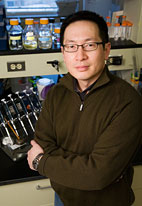

Thursday - August 2, 2007
SLAC Today is
available online at:
http://today.slac.stanford.edu
In this issue:
Floppy Hairs and Sound Waves
Science Today: Learning about QCD from String Theory
Fisher Donates Artwork to Director's Office
 |
 |
|
Thursday - August 2, 2007 |

Professor Gerard Wong (University of Illinois at Urbana-Champaign) and colleagues have found the molecular cause of one form of hearing loss.
Floppy Hairs and Sound WavesScientists exploring the physics of hearing have found an underlying molecular cause for one form of deafness. Malformed protein bundles can cause special sound-sensing hairs deep within the inner ear to lose their stiffness, destroying their ability to convert sound vibrations into nerve impulses. Now, a team of researchers working in part at the Stanford Synchrotron Radiation Laboratory (SSRL) have discovered what makes these hairs become floppy and relaxed. The findings appear in the February 2007 issue of the journal Physical Review Letters. Within the organs of the inner ear, sound waves stimulate microscopic hair cells called "stereocilia" and trigger nerve impulses that are transmitted to the brain. Filamentous actin (F-actin) is a rod-like protein that provides a structural framework in living cells, including auditory hair cells. F-actin is organized into bundles by espin, a linker protein found in sensory cells. When formed correctly, the F-actin bundles make up the normally rigid stereocilia. Using SSRL Beamline 4-2, researchers led by Gerard Wong from the University of Illinois at Urbana-Champaign mapped out the structure of bundles of espin and actin. The team learned that mutations in espin can cause actin in the bundles to "melt" into a liquid crystal, where molecules are aligned but only loosely connected. This makes the bundles much floppier, impairing the passage of vibrations and resulting in deafness. Wong says that, coincidentally, it's the same kind of molecular organization at work in a liquid crystal laptop screen—a type of order called "nematic" liquid crystalline organization. Because only a small percentage of espins must be normal to create normal bundles—and therefore stiffer stereocilia—therapies that address the espin mutations could one day lead to treatments for the disorder. "This is really the first step," says Wong. "We now have a good physical basis for understanding this phenomenon." |
||
|
|
||
 Learning about QCD from String TheoryQuantum Chromodynamics (QCD) is a very successful theory of the strong nuclear interactions, the interactions that bind together quarks to form protons. The theory is well tested when applied to high-energy reactions, including the processes of inelastic electron–proton scattering and quark production from electron–positron annihilation studied here at SLAC, and agrees excellently with the data. QCD has the property, called "asymptotic freedom," that its strong interactions become weak at high energies, allowing its predictions to be worked out systematically. At low energies, the QCD interactions become very strong, and it becomes difficult for theorists to make precise predictions. So far, most of our knowledge about QCD at low energies has come from simulating the theory on powerful computers. However, it seems that string theory can give us insight into strongly coupled low-energy QCD. During my visit to SLAC and Stanford over the past year, I have been using string theory to work out the properties of strongly coupled QCD and other similar theories. QCD involves quarks of three different types, called "colors." Hadrons—protons, pions, and other strongly interacting particles—are bound states of quarks with no visible color. The most basic properties of QCD would be similar if we change the number of colors, and it is interesting to think about this generalization, even considering the case in which the number of colors is very large. Many years ago, Gerard 't Hooft (of the University of Utrecht) showed that this limit of QCD with a large number of colors gives a string theory. The confinement of quarks into hadrons becomes obvious in this picture; every quark is connected by a string to an antiquark of the opposite color. It seems that the string theory of QCD is similar to the string theories that were later proposed to give "theories of everything." Many solutions of the equations of string theory are now known, and there are more to be discovered. It is not yet known which solution of string theory describes QCD with a large number of colors. Read more... |
Fisher Donates Artwork to Director's Office
Lylie Fisher, an Australian artist now based in the Bay Area, recently donated four prints to SLAC from her physics-themed In Search of Meaning series. The paintings, which were on display in the Research Office Building lobby for several months this summer, will now adorn the walls of the Director's Office Suite. "They're gorgeous; absolutely lovely," said SLAC Director Jonathan Dorfan of the paintings. "And we are very appreciative." The paintings are based on bubble chamber experiments conducted at SLAC more than 40 years ago. In the experiments, bubble chambers were filled with superheated, pressurized liquid. Particles passing through were captured by cameras from the bubbly trails they left behind. Fisher took enlargements of these photos, cropped them, and painted directly on the photos with acrylic paints. Both Fisher's and Dorfan's favorites include spiral tracks created by electrons, which are light enough to be strongly affected by the chamber's magnetic field. Dorfan is especially drawn to the work because he completed his Ph.D. thesis using a bubble chamber. "These paintings represent our search for meaning, both in the physical matter and art," Fisher said of her creations. "Both sides of the search are important, and these pieces place them together." See more of Fisher's work on her website and read a story about her work in symmetry magazine. |
Events (see all | submit)
Access (see all)
Announcements
|
| | ||
|
|
||
 <%
Response.AddHeader "Last-modified", getArticleDate()
'Response.AddHeader "Last-modified","Mon, 01 Sep 1997 01:03:33 GMT"
'Monday, December 06, 2010
%>
<%
Response.AddHeader "Last-modified", getArticleDate()
'Response.AddHeader "Last-modified","Mon, 01 Sep 1997 01:03:33 GMT"
'Monday, December 06, 2010
%>View online at http://today.slac.stanford.edu/. |
||